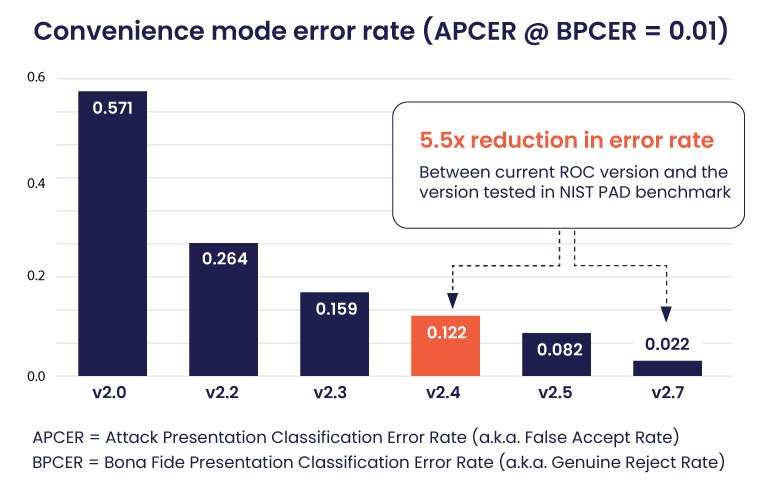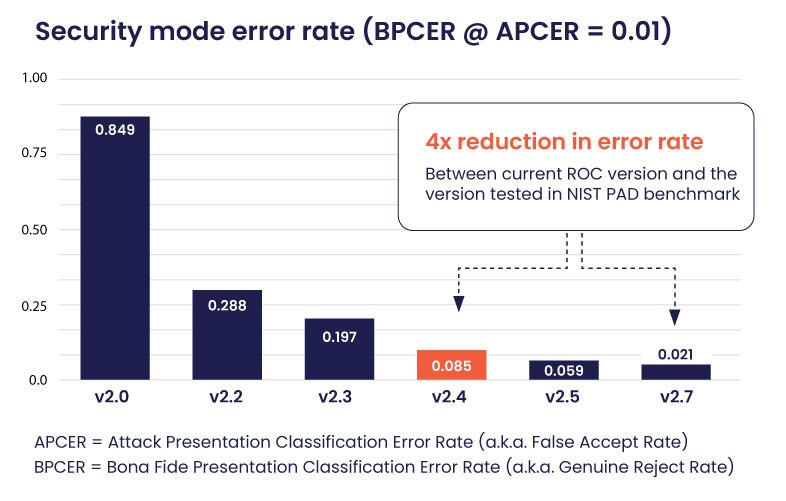Making the World Safer and Smarter
In today’s hyperconnected world, safeguarding our personal information is more important than ever. The digital landscape has evolved into an intricate lattice of personal data, with information collected, stored, and shared across innumerable platforms and devices. While this affinity has brought us unparalleled convenience in everyday life, it has also introduced a host of new vulnerabilities and challenges along the way.
Liveness Detection: Preventing Spoofing & Presentation Attacks
As a leading biometric and identity proofing provider, Rank One Computing (ROC) is excited to announce that the latest version of the ROC SDK, v2.7, includes a substantial improvement to Presentation Attack Detection (PAD). This algorithm recently passed iBeta Level 2 testing and comes hot on the heels of the first report on “Performance of Passive, Software-Based Presentation Attack Detection Algorithms” by the National Institute of Standards and Technology (NIST).
Often referred to as “spoofing,” a presentation attack is an attempt to impersonate someone using their physical characteristics or biometric data. Preventing an attack goes far beyond standard face recognition measures. It involves distinguishing real faces from fake ones, from simple photos and videos to highly sophisticated deep fakes and masks, ensuring the person on the other side is truly who they claim to be.
The NIST PAD report was based on the ROC v2.4 algorithm, which is several generations behind the latest version and has seen substantial accuracy improvements as highlighted below. Errors have decreased by over 4x since the NIST test, while the latest version includes added support for sophisticated spoof methods, such as silicon masks.

ROC error rates at detecting print and screen replay attacks over time when threshold applied maximizes user convenience. Error rate has been reduced by 5.5X between algorithm v2.4 (submitted to NIST) and the current v2.7 algorithm.

ROC error rates at detecting print and screen replay attacks over time when threshold applied maximizes security. Error rate has been reduced by 4X between algorithm v2.4 (submitted to NIST) and the current v2.7 algorithm.
Despite the fact that the v2.4 algorithm tested in the NIST PAD benchmark was already outdated, it was still a top performer in key categories:
- Detected video replay impersonation attacks with only 0.9% error rate
- One of the top performers at evasion detection
- The top performer at detecting mask evasion attempts
While the ROC algorithm did not excel on less prevalent attack vectors such as silicon masks, the latest version (v2.7) was specifically designed to handle these advanced instances. Level 2 PAD compliance from iBeta is representative of these improvements.
A World Leader in Computer Vision and Biometrics
ROC is committed to participating in future versions of the NIST PAD benchmark. Trusted by the U.S. military, law enforcement, fintech, and commercial organizations worldwide, our multimodal solutions deliver game-changing results with battle-tested reliability across NIST government testing, military applications, and 300M+ successful identity proofing transactions. We are employee-owned, ethics-driven, and 100% made in America.
